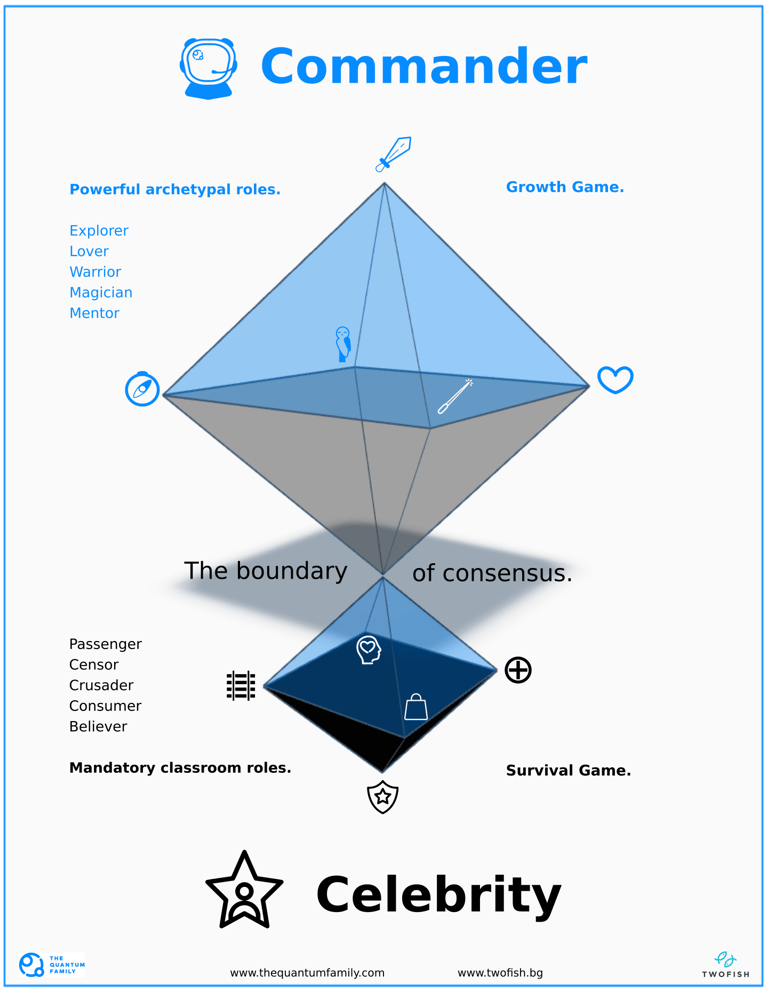If you believe the education system is out of date, then it's certainly time for growth.
Discover the significance of both survival and growth games.
Robert Maher
12/10/20244 min read
Abstract
The Quantum Family, as illustrated in the image, explores life as a balance between two essential "games"—the Growth Game and the Survival Game; one is sustained with a mandate while the other is driven by meaning. Together, these games form the foundation of reality, reflecting our need for stability and security alongside our drive for creativity and transformation. The image’s pyramids reveal the archetypes we embody in each game, from the empowered roles of the Growth Game (e.g., Explorer, Warrior, Magician) to the protective roles of the Survival Game (e.g., Passenger, Censor, Crusader).
This model reminds us that the games are not adversaries; they are distinct spaces we consciously navigate. By understanding the interplay of these archetypes and their dynamics, we can create a meaningful, balanced life that honors both our need for grounding and our desire for growth. The Quantum Family is an invitation to reconnect with these archetypes, cross the boundaries that confine us, and integrate the lessons of both games into a harmonious whole.


1. The Two Games: Growth Game and Survival Game
The Growth Game and Survival Game represent two complementary realities. The Survival Game is about preserving safety, stability, and societal order, anchored in our collective past and present. It prioritizes roles like the Passenger and Censor, which thrive in structured, predictable environments. In contrast, the Growth Game looks to the future, fostering creativity and innovation through roles like the Explorer and Magician. These games form distinct spaces, each serving a vital function in human life.
2. Archetypal Roles
The twelve archetypes represent the roles we adopt in each game. Growth Game archetypes are empowering, proactive, and transformative (e.g., Explorer, Lover, Mentor), while Survival Game archetypes are reactive, protective, and compliance-driven (e.g., Passenger, Censor, Crusader). These roles reflect different ways of engaging with reality, based on the game’s focus. Each role has its opposite, showing how similar qualities manifest either as potential (Growth) or limitation (Survival). Recognizing these archetypes helps us navigate life intentionally, choosing the role best suited for our circumstances.
3. The Boundary of Consensus
The boundary of consensus separates the two games, representing the transition from survival to growth. It reflects societal norms, personal fears, and institutional structures that keep individuals grounded in safety. Crossing this boundary requires courage, self-awareness, and a willingness to embrace uncertainty. However, it is a permeable line—those in the Growth Game can return to the Survival Game for grounding, while those in the Survival Game can rise into growth roles when ready. This boundary is the key to navigating both games with intentionality and balance.
4. Archetypal Central Roles: Commander and Celebrity
At the heart of each game lies a central archetype. In the Growth Game, the Commander symbolizes strategic leadership and the alignment of the internal family. This role bridges the archetypes of creativity and action, driving the group toward meaningful goals. In the Survival Game, the Celebrity represents the pinnacle of societal recognition, centralizing reactive roles around external validation. These central archetypes embody the ultimate drivers of each game—purpose and intrinsic growth for the Commander, and status and external safety for the Celebrity.
5. Context of Application
The Growth and Survival Games apply to all areas of life, including education, institutions, and personal development. In education, the Survival Game reflects standardized systems, while the Growth Game fosters curiosity and innovation. In institutions, Survival roles ensure order, while Growth roles drive change. On a personal level, we move between these games depending on circumstances—using the Survival Game to stay grounded and the Growth Game to stretch into new possibilities. This universal applicability makes the Quantum Family a practical framework for understanding human dynamics across contexts.
6. Role Interactions and Dynamics
The interaction between Growth and Survival archetypes creates a dynamic system. Growth roles like the Explorer often clash with their Survival counterparts, such as the Censor, reflecting tensions between freedom and control. However, these conflicts also offer opportunities for transformation—Growth roles can uplift Survival roles, just as Survival roles provide grounding for Growth. For example, a Mentor may guide a Passenger into becoming an Explorer, while a Warrior might rely on a Crusader’s discipline for focus. These dynamics emphasize the need for a balanced interplay between the two games.
7. Integration and Balance
The Growth Game and Survival Game are interdependent spaces that together form a dynamic and harmonious system. Their pyramidal structures reflect the natural relationships between archetypes, with the Survival Game emphasizing grounding and stability, while the Growth Game fosters exploration and transformation. The Survival Game provides safety and structure, offering a foundation upon which growth can occur. The Growth Game challenges boundaries, encouraging creativity and innovation.
Integration requires awareness of the distinct purposes of each game and the ability to navigate between them consciously. The Survival Game anchors us when we need stability, while the Growth Game opens doors to new possibilities when we are ready to evolve. By honoring both games and their roles in life, we create a balance that allows for personal and collective growth. This dynamic interplay is essential for thriving in an ever-changing world.
Conclusion
The Quantum Family invites us to see life as a balance between two essential games: the Growth Game and the Survival Game. The Survival Game anchors us with stability, providing safety and structure, while the Growth Game propels us into the unknown, fostering creativity and transformation. Together, these games form a complete system, but balance is key—overemphasis on one at the expense of the other creates disconnection and stagnation.
Standardized schools exemplify this imbalance, as they are trapped in the Survival Game, offering students only safety, structure, and compliance. While these are important, children also need the Growth Game, where they can explore, innovate, and evolve. This misalignment stems partly from an unimaginative and constrained academic leadership that clings to the familiarity of the past. Paralyzed by their own fear of change, such leaders perpetuate systems that fail to meet the dynamic needs of learners.
The Quantum Family challenges us to break free from this stagnation. By embracing both games, crossing the boundary of consensus intentionally, and integrating their lessons, we can create spaces where individuals—especially children—thrive. This philosophy is a call to reimagine education and life itself, where growth and stability, security and possibility, are in harmony. Only then can we co-create a future where both games contribute to the whole.
Discover TwoFish, a growth game designed for primary school children.


